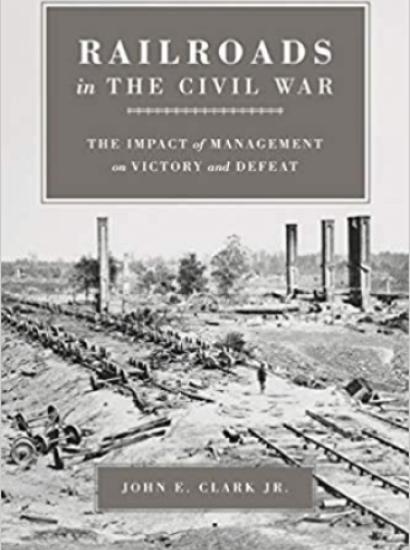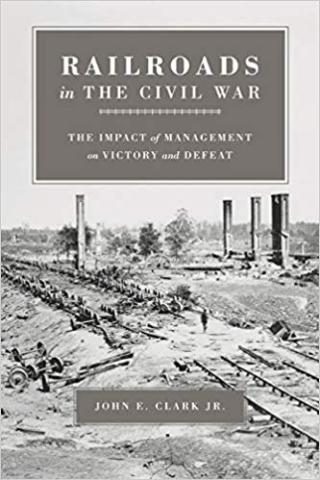This short volume illustrates the importance of management practices and political culture in adapting an emerging technology to the demands of war. The author’s position is clear—Clark contends that despite having a considerable number of rail lines within its territory, the basis of the claim that the South had an advantage early in the conflict in the form of “internal lines of communication,” and the legal authority to take control of the railroads for military purposes, the Confederate leadership “proved unable” to recognize the increasing importance of logistics as the conflict wore on.
Clark argues that the war began as a traditional Napoleonic-style conflict in which armies generally “limited their campaigns to populated areas because they depended on local food supplies for sustenance.” Food and forage requirements also impelled armies to keep moving so as not to exhaust local resources. But such tactics were not feasible in the sparsely populated American South where the war was increasing fought, and it was railroads that delivered troops and supplies to sustain Union armies as they moved across Virginia, Tennessee, Georgia, and Mississippi.
Railroads were an emerging technology when the U.S. Civil War began, and the new, rapid mode of transporting large quantities of personnel and materials changed several key elements of warfare. The tempo of the war quickened as the range of combat expanded from the initial battles near Washington, D.C., and both sides undertook a significant number of campaigns aimed at destroying enemy rail lines, junctions, and storage depots.
Clark presents his argument as a case study of the command decisions and rail logistics involved in two troop movements. The first is the transfer of 13,000 troops under Confederate General James Longstreet from Virginia, dispatched to northwestern Georgia to reinforce General Braxton Bragg’s Confederate Army of Tennessee, which opposed Union General William S. Rosecrans as his Army of the Cumberland marched towards Atlanta following the capture of Chattanooga. Though only half of Longstreet’s troops reached Bragg in time to join the battle against Rosecrans, that was enough to secure Confederate victory in the Battle of Chickamauga between September 18 and 20, 1863. The loss prompted the second troop movement of the case study, the transfer of 23,000 soldiers of the 11th and 12th Corps of the Union Army of the Potomac.
Like Longstreet’s troops, the Union force journeyed from Virginia to Tennessee by rail. But Clark contends that the mode of transport is the only similarity between the two logistical operations. The Confederate leadership took two weeks to decide to dispatch reinforcements under Longstreet’s command. The decision made, implementation soon exposed the lack of cooperation between Southern civil and military leadership, the poor condition of the Southern rail lines, and the power of the states’ rights doctrine underpinning the Confederate government as a factor preventing the army from taking control of rail assets at a critical juncture on the war. As a result, Longstreet’s troops had to travel 950 miles across a patchwork of local rail lines to reach Bragg’s army.
Union reinforcements began boarding trains within five days of the defeat at Chickamauga. The Union’s quartermaster command included several experienced railroad executives, and some had studied the operational needs of large troop movement by rail in 1862. In a special meeting at the War Department on September 24, 1863, Secretary of War Stanton revealed his plan to move troops by rail to dramatically reduce the time needed to send such a force from the 40 to 60 days that military commanders estimated. The first troops reach Chattanooga on September 30, the last on October 16. The rail route and logistics management system thus established was kept in operation, turning Chattanooga into the supply depot for General William T. Sherman’s march on Atlanta, which began in May of 1864.
At the time, Clark notes, the logistics achievement of moving the 11th and 12th Corps troops went virtually without notice. But the operation reflected the underlying differences in the structure of the Union and Confederate economies, and the railroad industries in each region when the war began. The small widely-dispersed population centers of the South, based on seasonal agriculture rather than manufacturing, resulted in construction of rail lines serving local needs. Clark describes how states’ rights doctrine encouraged local operators and states to resist Confederate efforts to enlist rail lines in support of the war effort, and the Confederate reluctance or refusal to pay private operators adequate fares for use of their lines and rolling stock limited the logistical resources available to support the Southern war effort. Strategically, the fragmented Southern rail industry prevented the Confederate government from pirating rails and other parts from local lines to maintain major routes.
Railroads were significantly more advanced in the North when the war began. In 1860, Clark notes, the four largest revenue-producing Northern railroads on average operated 80% more track miles and generated 80% more revenue than the four largest Southern railroads. Northern railroad executives had borrowed military organizational and managerial practices such as the chain of command and span of control, and to this they added antebellum experience with operational efficiency such as uniform track gauges, increasing the speed and profitability of service by loading cars for through-shipping instead of re-packaging goods at junctions.
As a concise study of the strategic, managerial, and decision-making aspects of military logistics at a time of technological change, Clark’s monograph is a valuable contribution to an important topic that typically receives scant notice in the extensive Civil War battle literature focused on battle tactics. He references the traditional studies of Civil War railroad operations, which were published in the 1950s, but gives modern readers a broader perspective than the basic sources that focus more on regional conditions or the details of mis-matched rail gauges in the early days of railroad development. Illustrated by numerous maps, photos of Union and Confederate quartermasters, and photos of rail lines and rolling stock, Clark provides important context for the Battle of Chickamauga and the subsequent development of Chattanooga as a large-scale supply depot that made Sherman’s march possible.
















